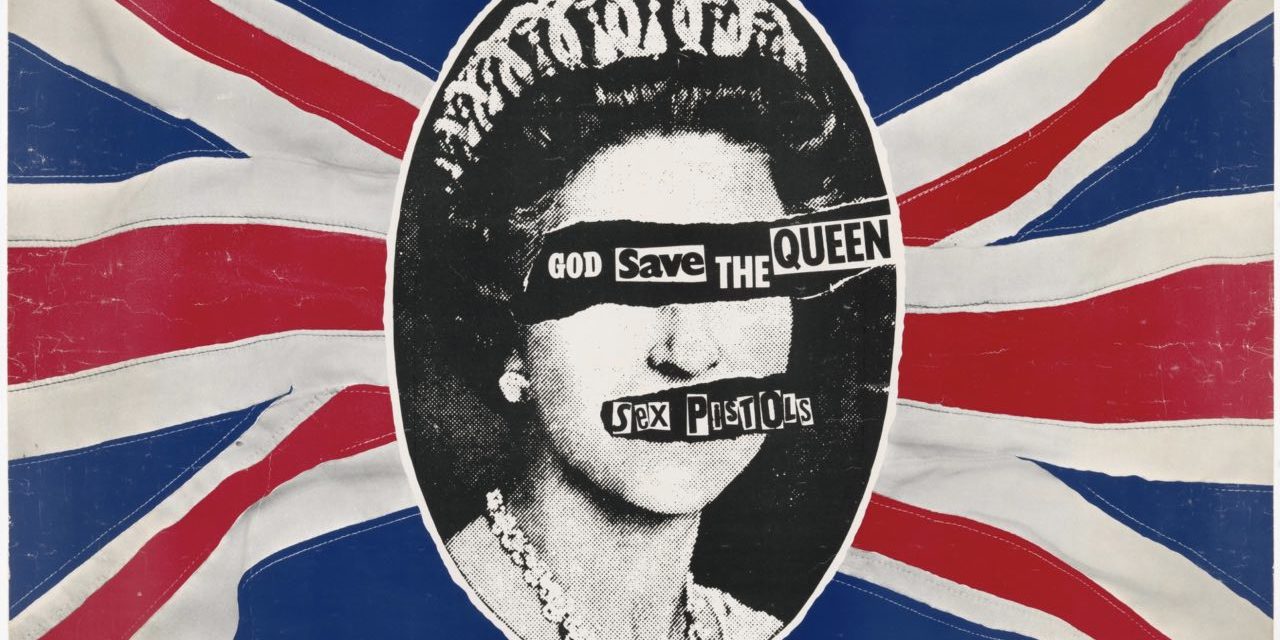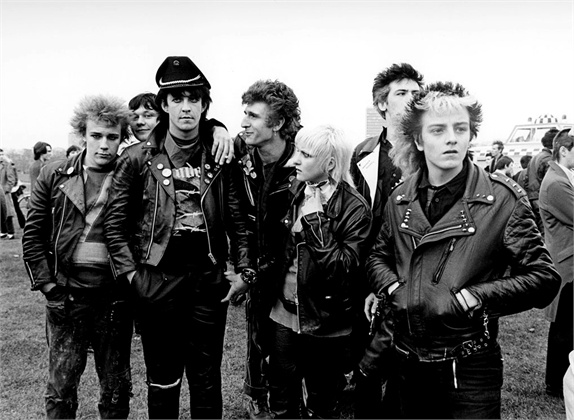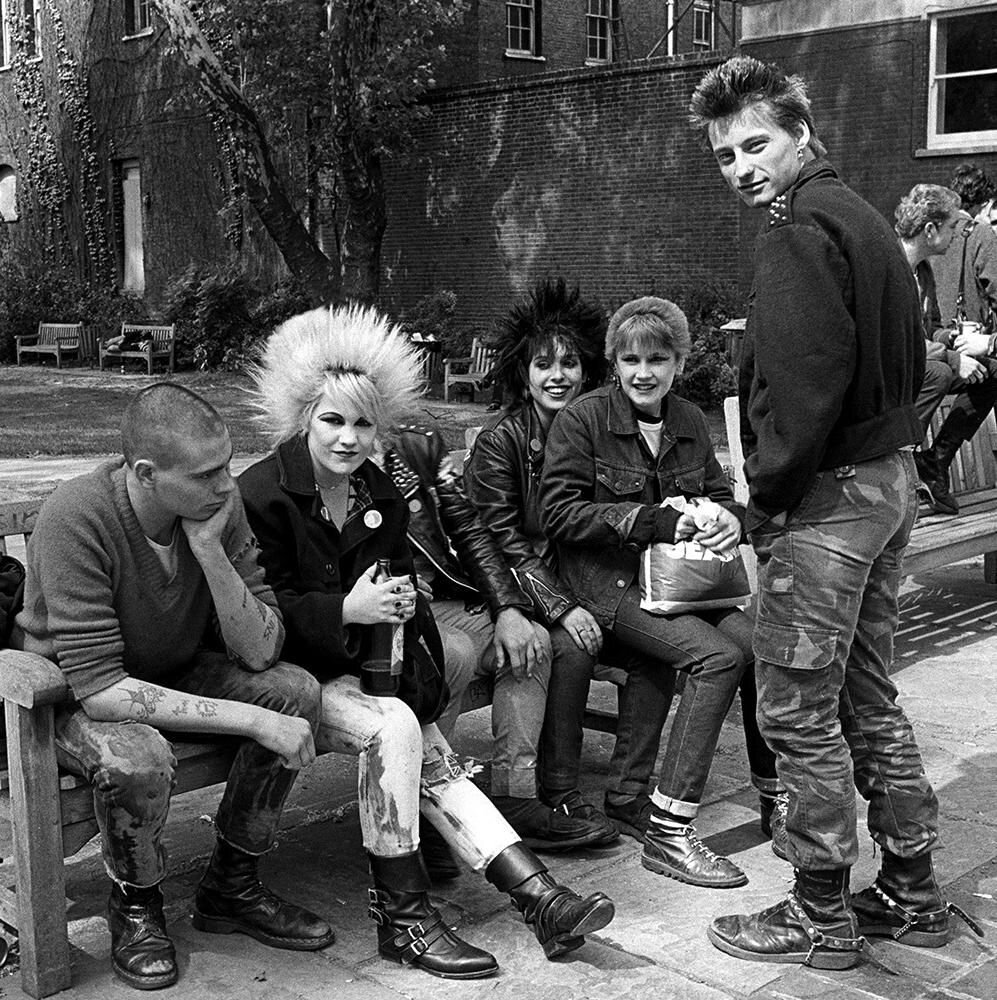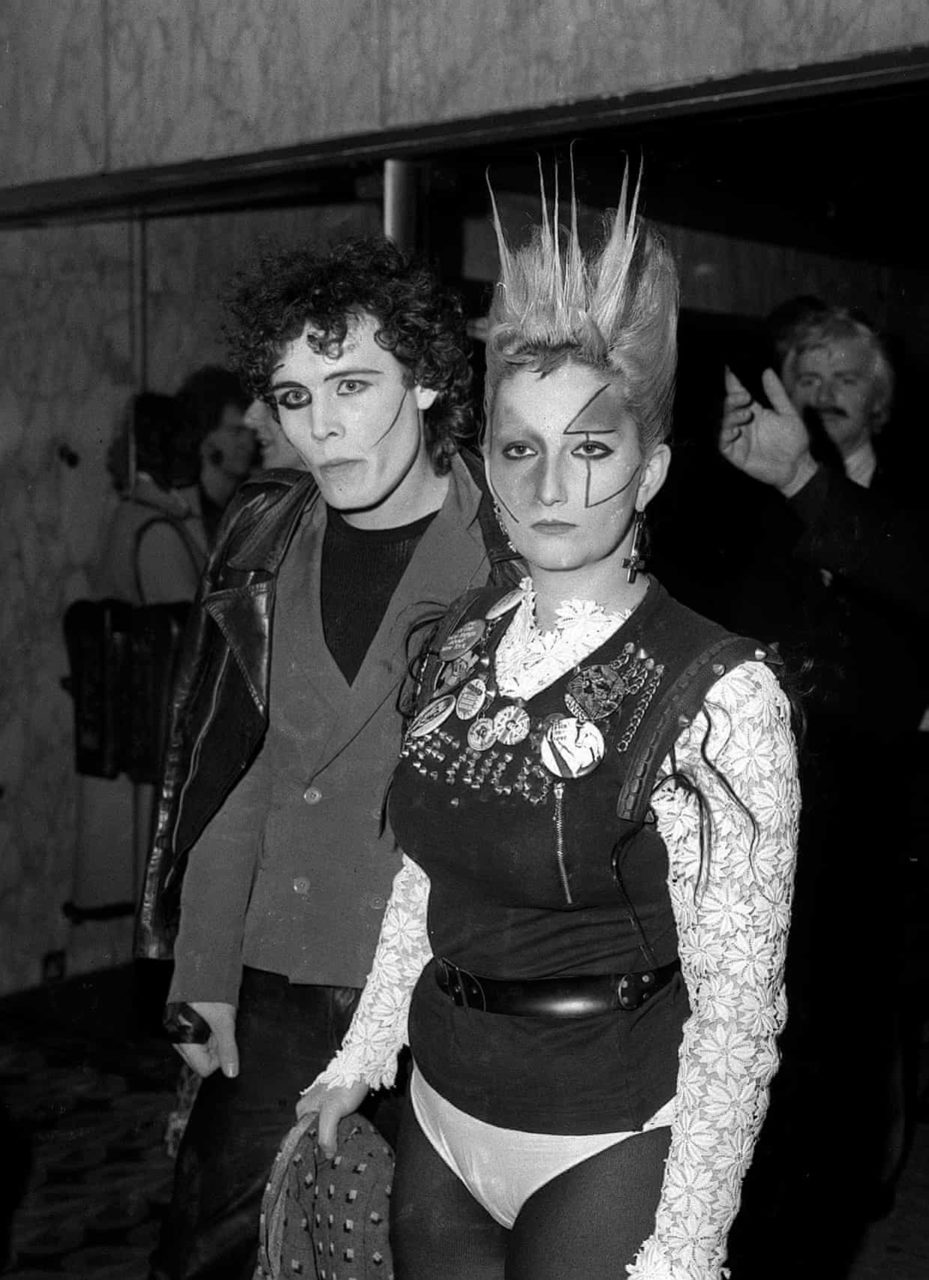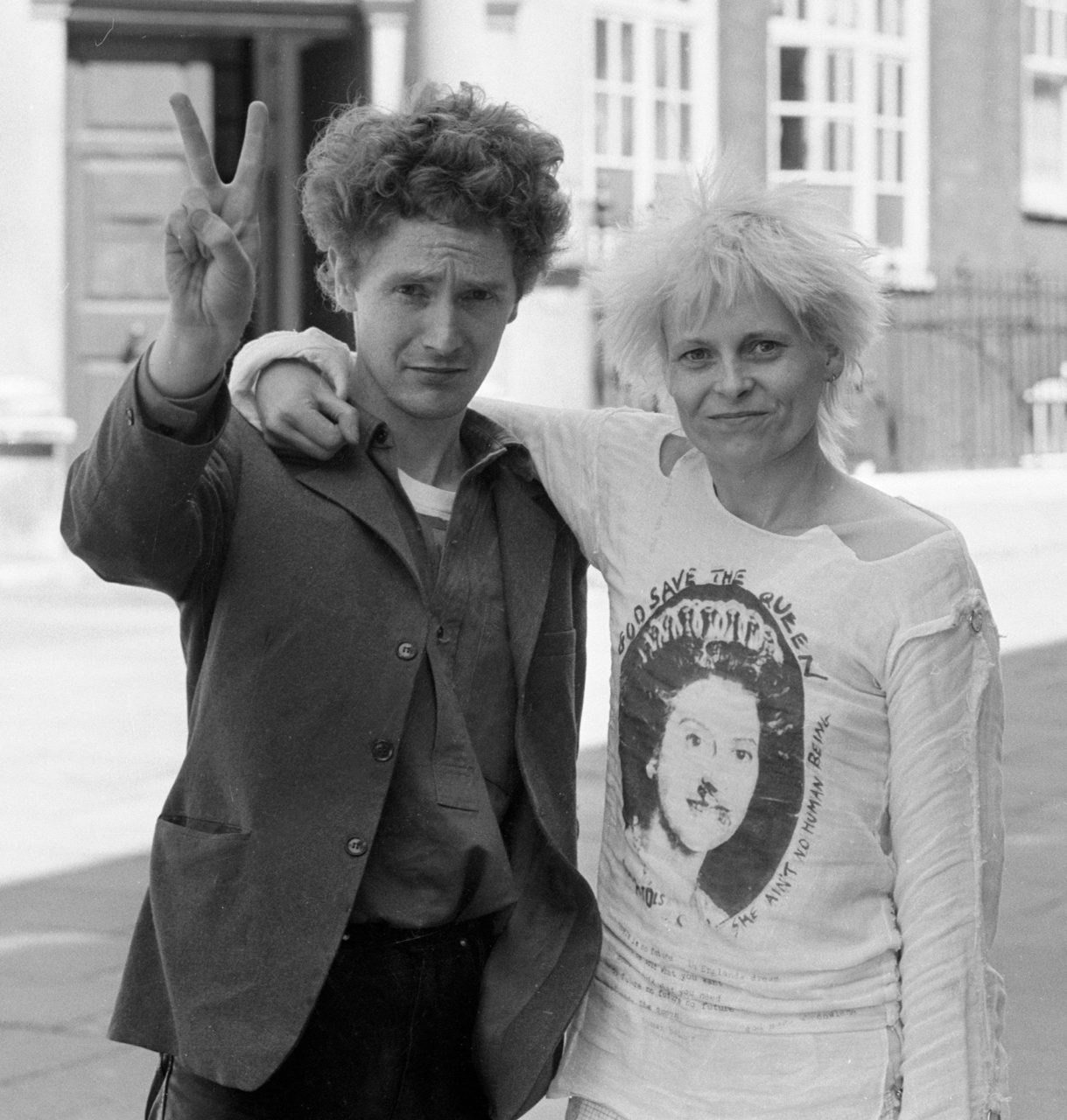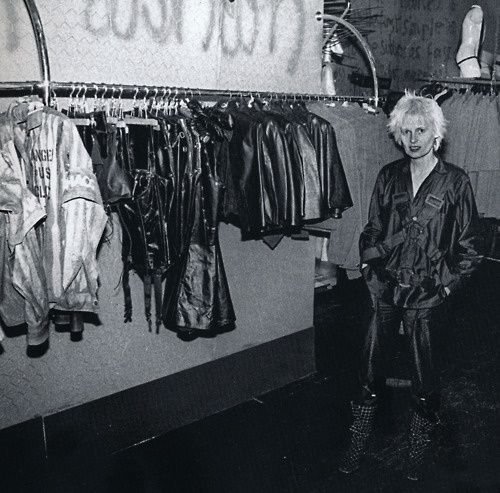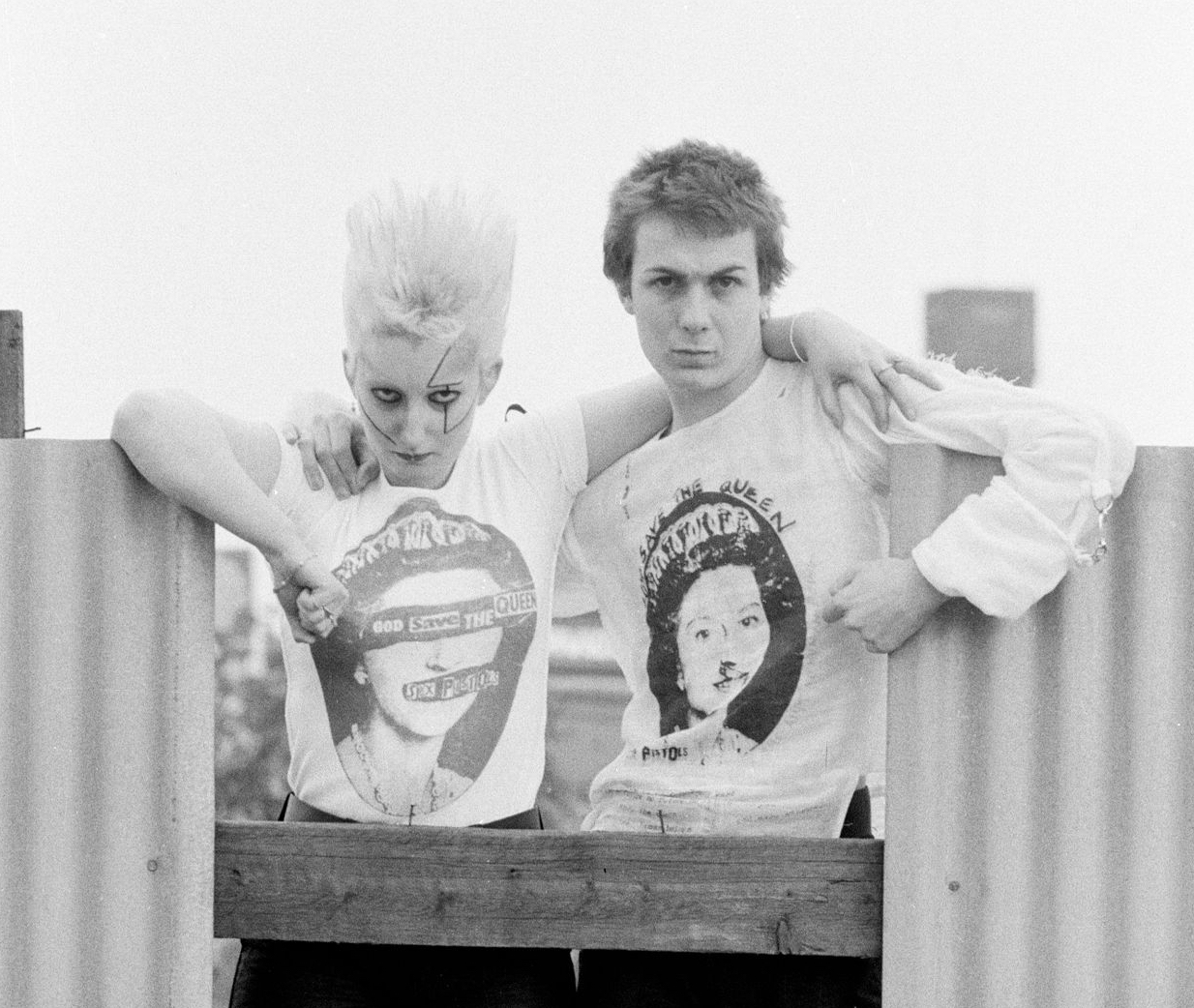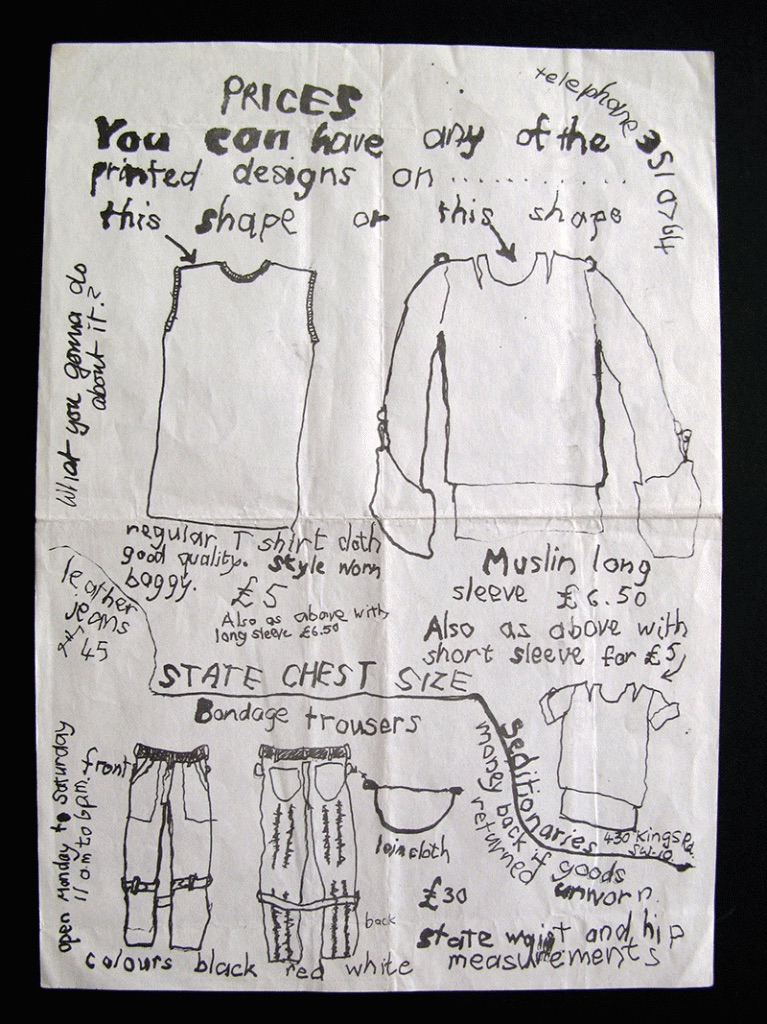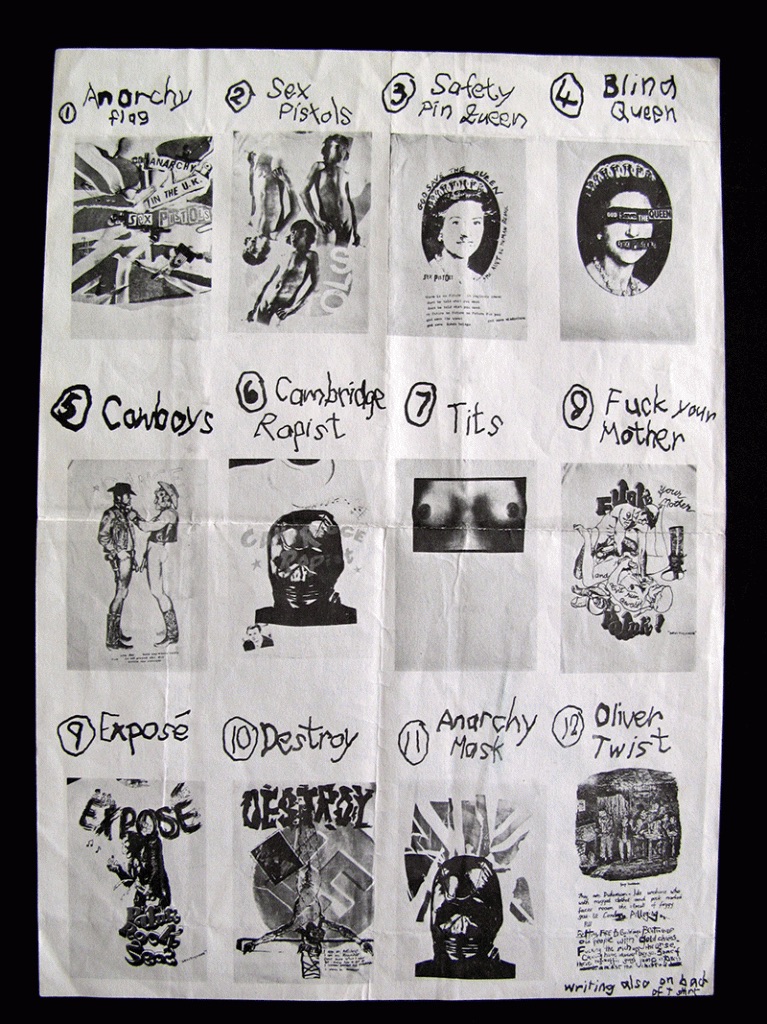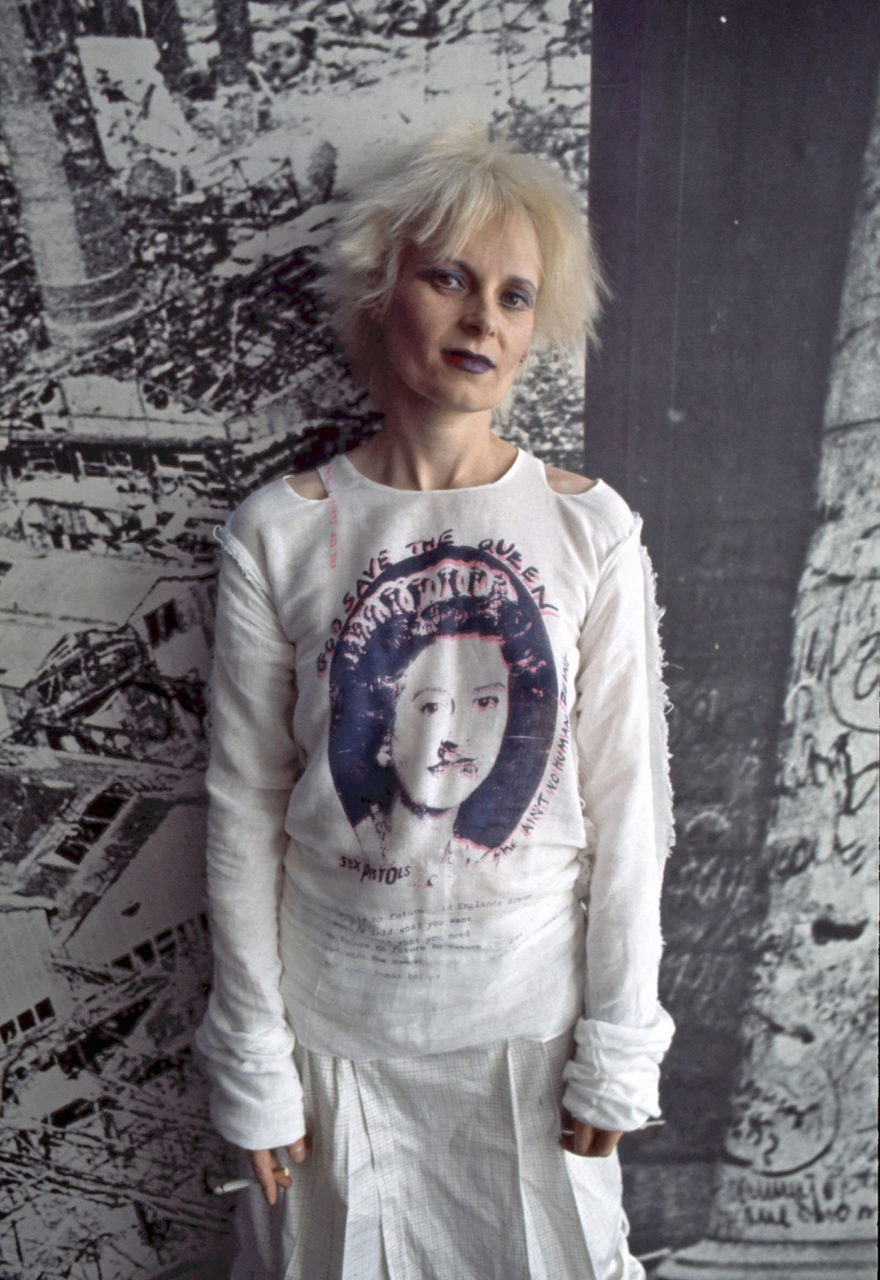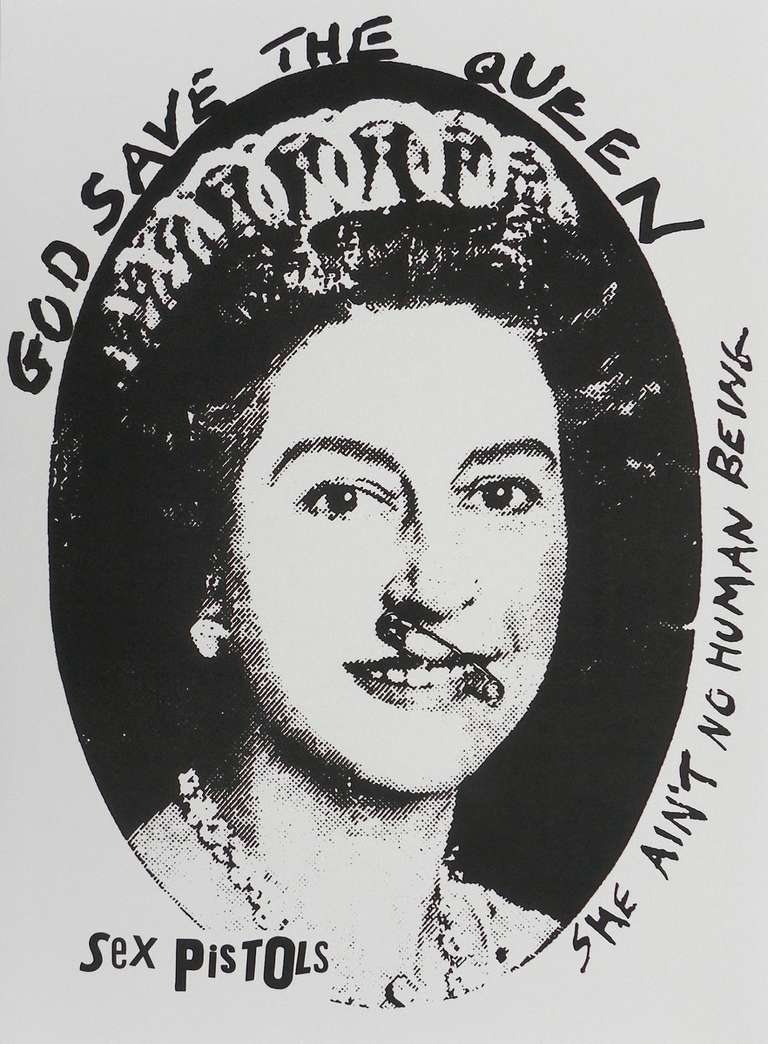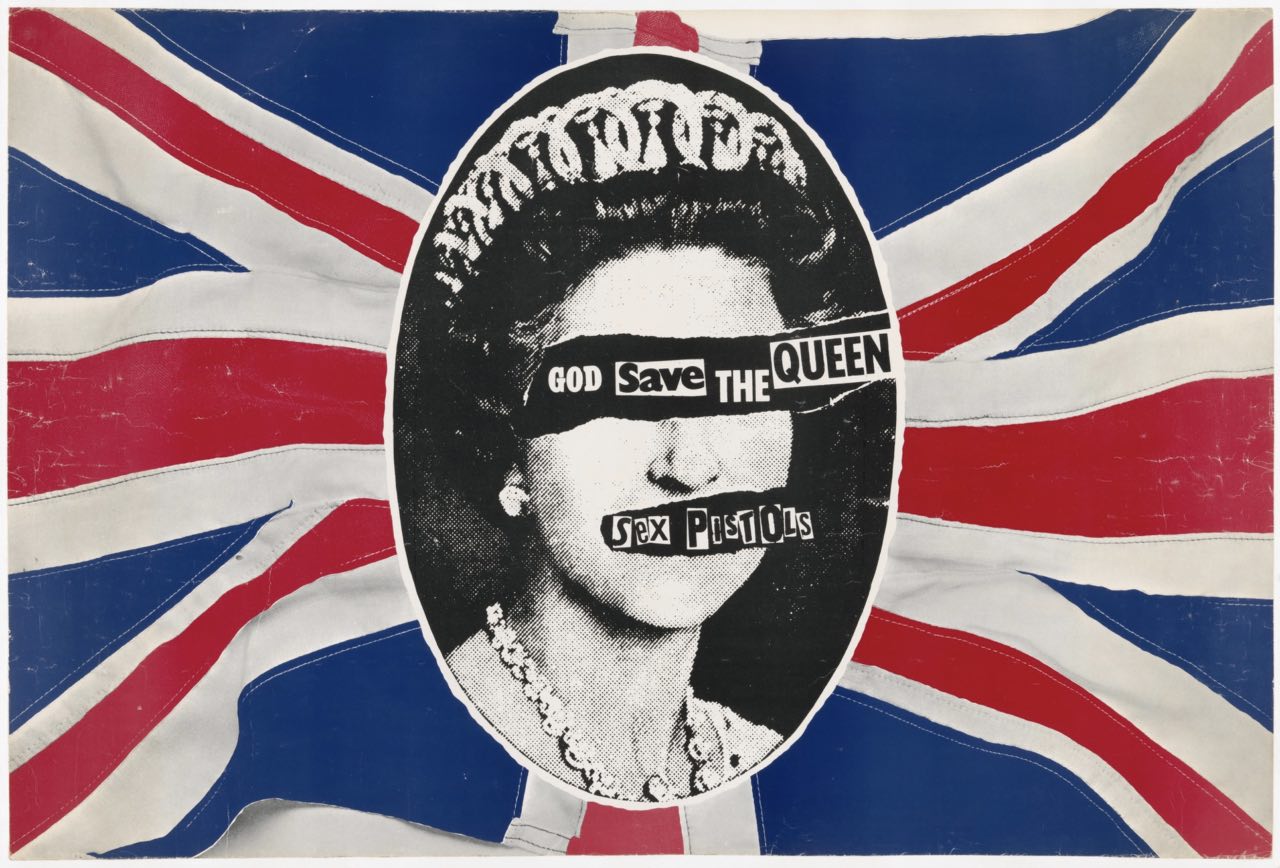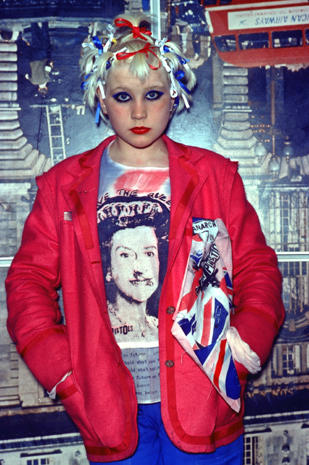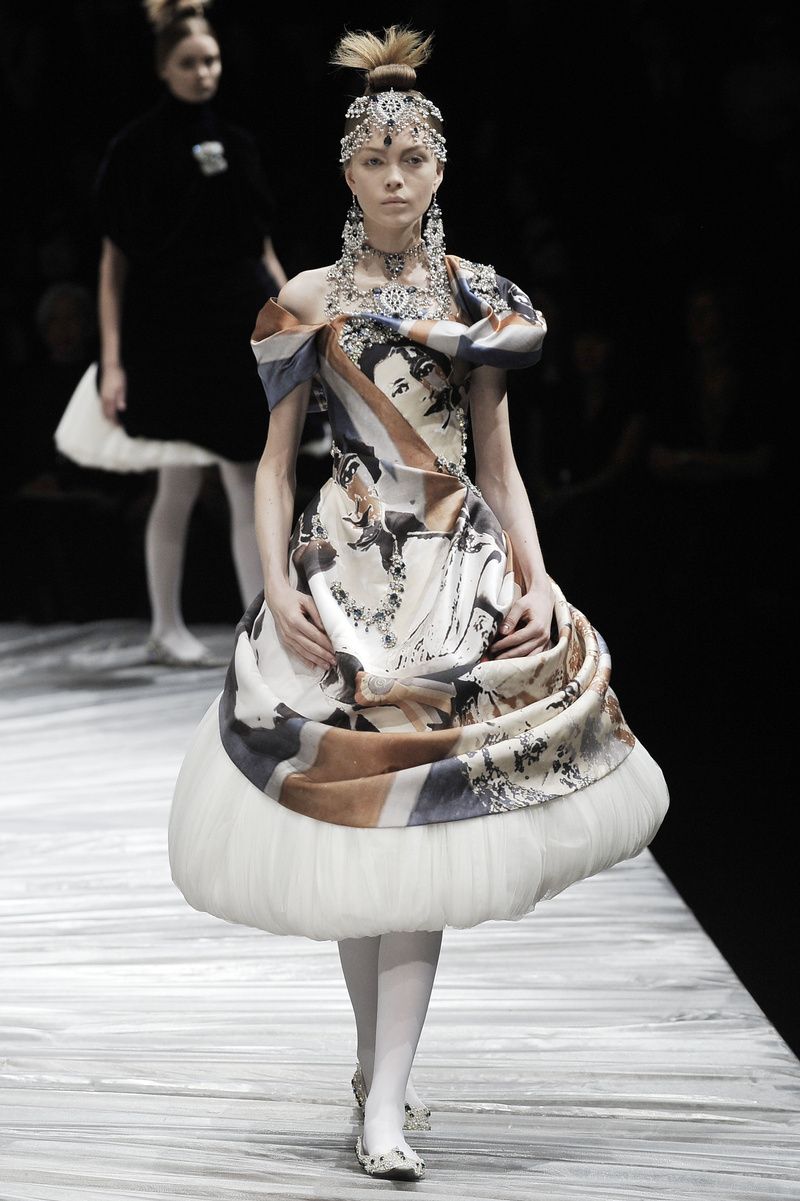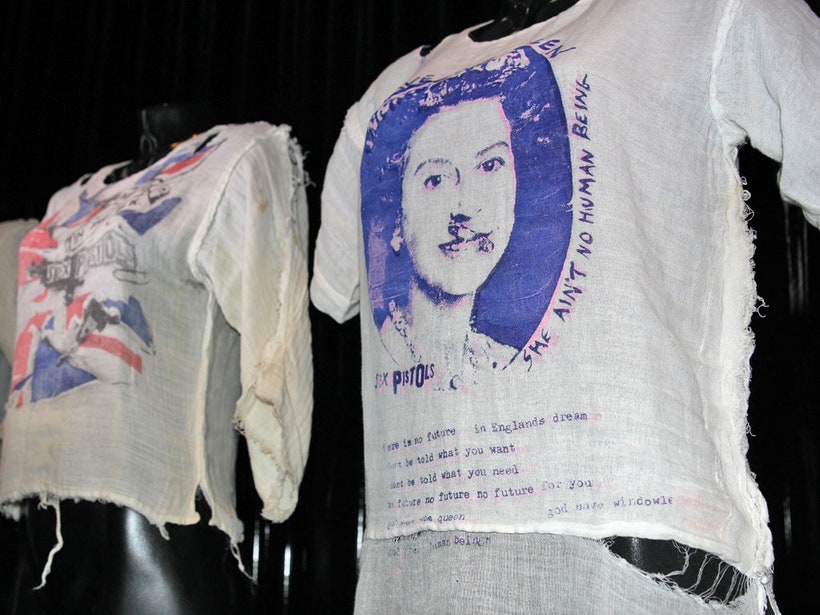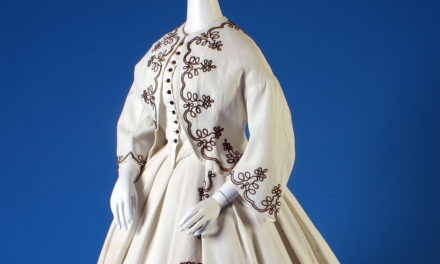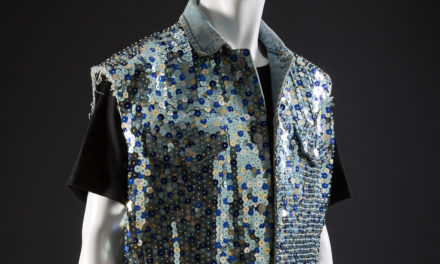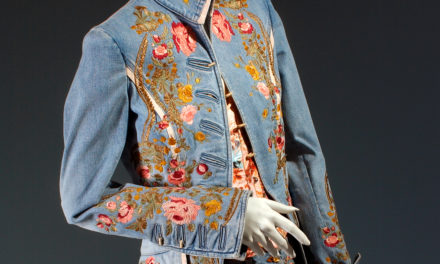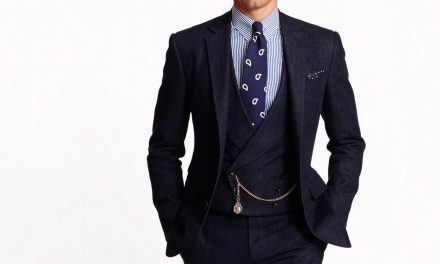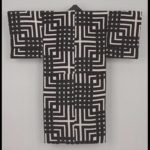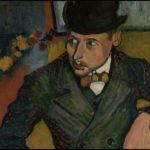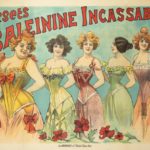Vivienne Westwood and Malcolm McLaren’s “God Save the Queen” T-shirt is a white, long-sleeve shirt with distressed elements and a bold graphic by Jamie Reid featuring lyrics to the Sex Pistols song. It has become an iconic representation of early British Punk style.
About the Look
Iconic British designer Vivienne Westwood, with Malcom McLaren, designed the “God Save the Queen” T-shirt, a white, long-sleeve t-shirt with distressed elements and a bold graphic on the front, in 1977. The seams at the armholes, sleeves, and side seams are sewn so that the raw edge of the white knit fabric is visible. There are small oval cutouts on the shoulders of the shirt on each side of the neckline. On the front, there is a bold red and blue graphic depicting Queen Elizabeth II of England with a safety pin on her face. The lyrics to the song “God Save the Queen” by the Sex Pistols, surround this image along with the band’s logo. There are metal rings sewn to the outer sleeve seam at the shoulder and small metal clasps dangle at the cuffs. There is a second tier of white knit fabric on the front and the back of the shirt at the hem. The shape of the shirt is boxy, hanging from the shoulders as opposed to being anchored at a different point, such as the waist.
Vivienne Westwood (British, born 1941) and Malcolm McLaren (British, 1946–2010). “God Save the Queen” T-Shirt, 1977. Cotton, metal. New York: Metropolitan Museum of Art, 2018.786. Purchase, Friends of The Costume Institute Gifts, 2018. Source: The Met.
About the context
The “God Save the Queen” t-shirt was created by Westwood and McLaren in 1977, the same year that Queen Elizabeth II would celebrate her Silver Jubilee, marking twenty-five years of her reign as the Queen of England. In the summer of 1977, various royal pageants and celebrations were set to take place to commemorate this occasion. In the Punk world, the summer of 1977 became known as “the Summer of Hate” (Westwood and Kelly 206). This garment reflects the style of the Punk subculture in London. The Punk look took elements from 1950s greaser style, which included tight jeans, work boots, and leather jackets (Figs. 1, 2). The Punks updated this look through slashing, studs, rips, safety pins, and other methods of distressing (Fig. 3). A large part of the Punk look were t-shirts emblazoned with provocative and controversial images (Reddy). This garment is an example of anti-fashion. It was not meant to be worn by those participating in Fashion or for the general public. It catered to a very specific subculture: Punk.
This t-shirt, designed by Westwood and McLaren (Fig. 4), was made in London and sold at their shop, Seditionaries (Fig. 5), at 430 Kings Road in London. This shirt is emblematic of their designs, particularly of their long-standing involvement in both music and clothing design. The various shops owned by Westwood and McLaren famously catered to other music subcultures before it became fully dedicated to Punk. 430 Kings Road was initially home to “Let it Rock”, which catered to the Teddy Boy subculture. In 1972 the shop was renamed “Too Fast to Live, Too Young to Die.”
In 1974 it became “SEX” and the Punk aesthetic of the shop began to emerge along with fetish clothing. By the time the shop was became “Seditionaries” it was established as a place to find Punk clothing (Cole and Deihl 327); catering to the Punk subculture, and this shirt embodies that look. The “God Save the Queen” T-shirt is emblematic of Westwood and McLaren’s design aesthetic from this period. Vivienne Westwood said,
“I did not see myself as a fashion designer, but as someone who wished to confront the rotten status quo through the way I dressed and dressed others.”
This philosophy is evident in this t-shirt, as it directly challenges the ideas of England’s monarchy with its graphic ridiculing the queen, along with the Sex Pistols’ highly controversial lyrics. Elements such as rips and slogans are emblematic of the designs sold at Seditionaries (Figs. 6-8). These elements were included to directly contrast the existing rules of fashion. This aesthetic was described by McLaren as “damage-driven clothes,” and by Westwood as “clothes for modern heroes.” The styles sold at Seditionaries were essential in spreading the Punk style (Westwood and Kelly 183).
Fig. 1 - Virginia Turbett (British, born 1957). Young Punks at the Sid Vicious Memorial March in London, 1979. Photograph. Source: Getty Images
Fig. 2 - Janette Beckman (British, born 1959). Punks gathered at King's Road in London, 1979. Photograph. Source: Getty Images
Fig. 3 - Photographer unknown. Punk Rockers Adam Ant and Jordan attending the movie premiere of "Saturday Night Fever" in London, 1978. Source: Getty Images
Fig. 4 - Bill Kennedy (British, 1947-2018). Malcom McLaren and Vivienne Westwood, 1977. Photographed for The Daily Mirror. Source: Vogue
Fig. 5 - Photographer unknown. Vivienne Westwood in her shop, Seditionariess, ca. 1977. Source: Pinterest
Fig. 6 - Bill Kennedy (British, 1947-2018). Punk fashions for him and her from Seditionaries, May 18, 1977. Source: Getty Images
Fig. 7 - Vivienne Westwood and Malcolm McLaren (British). Seditionaries Mail Order, ca. 1977. Source: World's End
Fig. 8 - Vivienne Westwood and Malcolm McLaren (British). Seditionaries Mail Order, ca. 1977. Source: World's End
Fig. 9 - Elisa Leonelli (Italian, 1973-2017). Vivienne Westwood, 1977. Source: Vogue
There are very clear influences from other forms of art in this T-shirt, including music and graphic design. The main graphic on the front of the shirt was designed by Punk graphic designer, Jamie Reid, and depicts Queen Elizabeth II with a safety pin on her face (Fig. 10). It is a variation on the artwork for the Sex Pistols’ 1977 single (Fig. 11), “God Save the Queen” (“Jamie Reid”). The graphic takes inspiration from the Punk movement’s look itself. At the time it was designed, safety pins had been established as a staple of Punk accessorizing, so by including it in the graphic, Reid was taking inspiration from Punk style. This t-shirt also features the lyrics to the Sex Pistols song “God Save the Queen” and the band’s logo.
This garment does not uphold the fashionable styles or beauty practices from the time, as it was a garment to be worn by a person who was a member of the Punk subculture. This was a subculture that aimed to subvert conventional ideals through the way they dressed and presented themselves. Since it did not ascribe to the ideal silhouette of the time period, no particular undergarments had to be worn under this t-shirt. In her autobiography, Vivienne Westwood recalls that in a police description it was noted that her shop assistant, Debbie Juvenile (Fig. 12), had her nipples showing under her shirt. In the Punk subculture, it was acceptable to forgo undergarments (Westwood and Kelly 207). Other aspects of the Punk look subverted the beauty ideals of the time. Instead of long, voluminous hair, Punks often had short, choppy, and colorful, hair. Many hairstyles were extreme, with spikes or a disheveled appearance (Cole and Deihl 316), and they applied makeup to appear unnaturally pale. Although the subcultural Punk look and the accepted beauty standards of the time are wildly different, both had tendencies towards the unnatural.
Fig. 10 - Jamie Reid (British, born 1947). God Save the Queen, 1977. Screenprint; 101.5 x 74 cm (40 x 29 1/10 in). Source: Artsy
Fig. 11 - Jamie Read (British, Born 1947). "God Save the Queen", 1977. Lithograph; 69.9 x 100.3 cm (27 1/2 x 39 1/2" in). New York: Museum of Modern Art, 217.2012. Gift of Lawrence Benenson. Source: MoMA
Fig. 12 - Photographer unknown. Debbie Juvenile, an assistant in Westwood and McLaren's shop Seditionaries, models Westwood's Jubilee outfit, 1977. Courtesy of Vivienne Westwood. Source: CBS News
One of the famed wearers of this garment is Vivienne Westwood herself (Fig. 9). This is a testament to the idea that women designers can be their own muses; designing clothing that they themselves would wear. Vivienne Westwood was a true example of this, as she has not only been photographed wearing the “God Save the Queen” t-shirt, but many of her other designs sold at 430 Kings Road. On one occasion Vivienne Westwood was photographed wearing it for the “Punk Jubilee” during the summer of 1977. Malcom McLaren, who was also the manager of the Sex Pistols, hired a boat to travel down the River Thames and stop near the Palace of Westminster. Upon arrival, the plan was to blast the Sex Pistols’ song “God Save the Queen” as a publicity stunt. Westwood, McLaren, the band, and over 200 fans were on the boat when it ended up being boarded by the police. McLaren was arrested and Westwood accompanied him to the Bow Street Police Station and spent the night there, although she was not arrested. Vivienne was documented wearing this shirt in a photograph and in a video reel, as McLaren had hired people to film the event.
Its Afterlife
T
he “God Save the Queen” T-shirt was mentioned in a 1977 Women’s Wear Daily (WWD) article about designer Zandra Rhodes’ interpretation of Punk in her own designs. Westwood and McLaren were noted for their foundational role in Punk:
“Seditionaries, the Kings Rd. shop which was the first to sell Punk fashions, and the originator of many of the ideas, feels Punk is just beginning to take off in a big way. So far, its best sellers are the bondage trousers… and the “God Save the Queen” t-shirt, with a photo of her majesty with a safety pin through her nose and mouth.” (Wade)
The shirt’s influence can be seen in a look from Alexander McQueen’s Fall 2008 collection (Fig. 13). The dress features imagery Queen Elizabeth II and the British flag and is similar to the “God Save the Queen” t-shirt in its modification of iconic British imagery in a way that deconstructs their appearance and meaning. The “God Save the Queen” t-shirt does this through its confrontational graphic and Alexander McQueen achieves this through pleats and drapes that distort the imagery.
A version of the shirt appeared in Costume Institute’s 2013 exhibition, “PUNK: Chaos to Couture”—at the Metropolitan Museum of Art (Fig. 14) and is now part of the department’s permanent collection. Westwood and McLaren’s designs, along with the songs made by the Sex Pistols, have become iconic representations of early British Punk, and remain emblematic of a moment in cultural history.
Fig. 13 - Alexander McQueen (English, 1969–2010). Look 29, Fall/Winter 2008. Photo by Marcia Madeira. Source: Vogue
Fig. 14 - VIvienne Westwood (British, born 1941). The "God Save the Queen" t-shirt on view in the "PUNK: Chaos to Couture" exhibition, 2013. New York: Metropolitan Museum of Art. Photograph by Tara Abell. Source: Condé Nast Traveler
References:
- Cole, Daniel James, and Nancy Deihl. The History of Modern Fashion from 1850. London: Laurence King Publishing, 2015. http://www.worldcat.org/oclc/900012311.
- “Jamie Reid.” ArtNet, ArtNet Worldwide Corporation, www.artnet.com/artists/jamie-reid/.
- Reddy, Karina. “1970-1979.” Fashion History Timeline, 11 Oct. 2019, fashionhistory.fitnyc.edu/1970-1979/.
- Wade, Valerie. “Punk Progress Report: Zandra Rhodes.” Women’s Wear Daily, 13 June 1977, p.3. ProQuest, http://libproxy.fitsuny.edu:2818/wwd/docview/1700043671/41BA2F61AB5A4B58PQ/3?account id=27253.
- Westwood, Vivienne, and Ian Kelly. Vivienne Westwood. Picador, 2014. http://www.worldcat.org/oclc/925834597.

